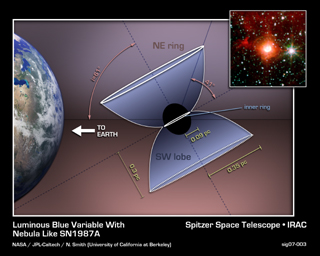
Click on the image for full resolution
Poster Version of DiagramA luminous blue variable star (inset) in our galaxy, named HD168625, surrounded by a bipolar nebula that is similar to the one around SN1987A. SN1987A was a supernova that exploded in 1987 in the Large Magellanic Cloud, and was the nearest supernova in about 400 years.
The diagram explains the bipolar nebula around HD168625, which has a geometry that makes it a near twin of the famous nebula around SN1987A. Rings near the equator are sometimes seen around stars that shed mass from their surfaces, but the larger rings above the poles are very rare. Tipped toward Earth and illuminated by the star, the rings look like ellipses in images taken with NASA's Spitzer Space Telescope.
The image was taken in 2004 by the infrared array camera on Spitzer at wavelengths between 3.6 and 8 microns. The massive star at the center, which lies within the constellation Sagittarius, is about 7,200 light-years from Earth.

